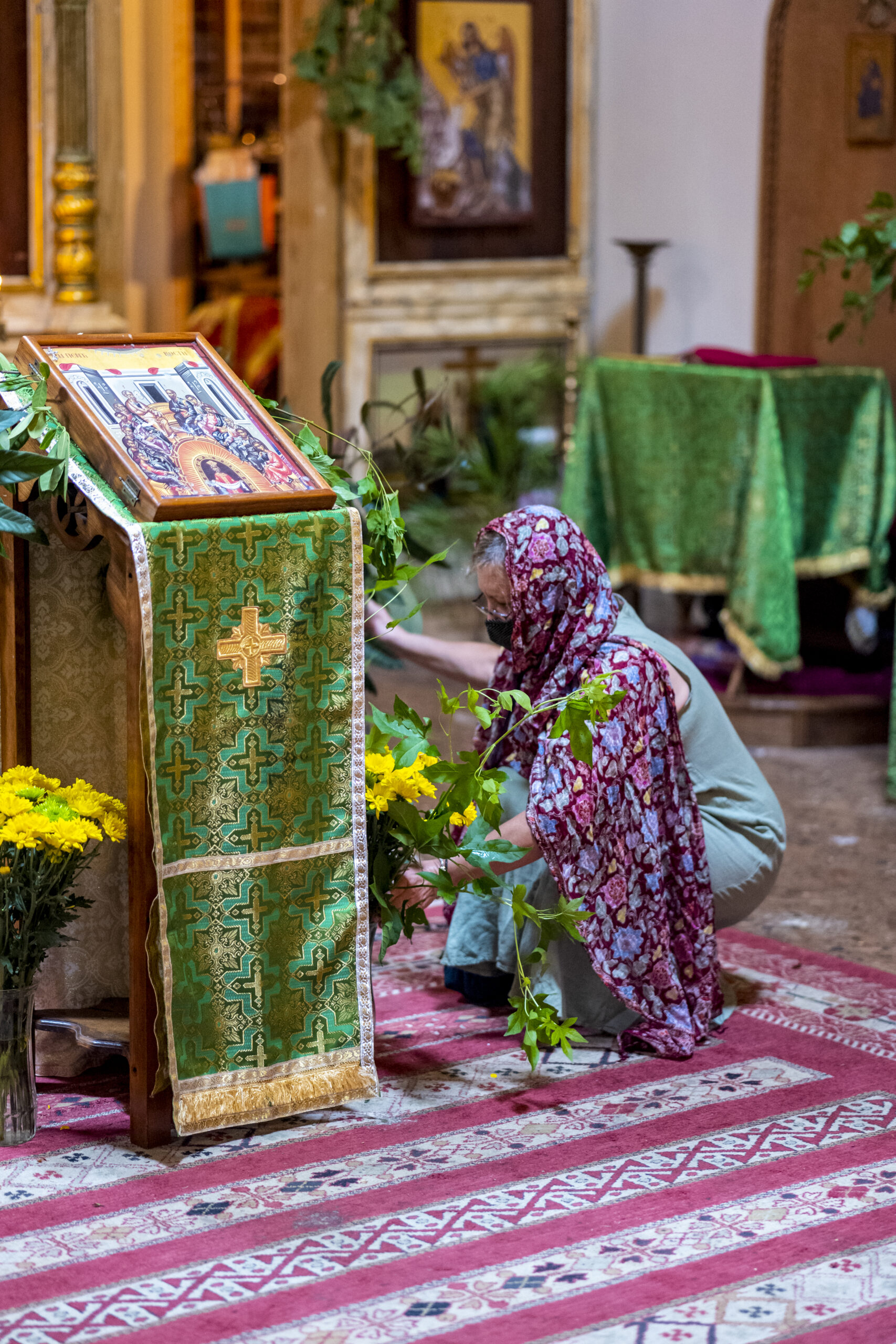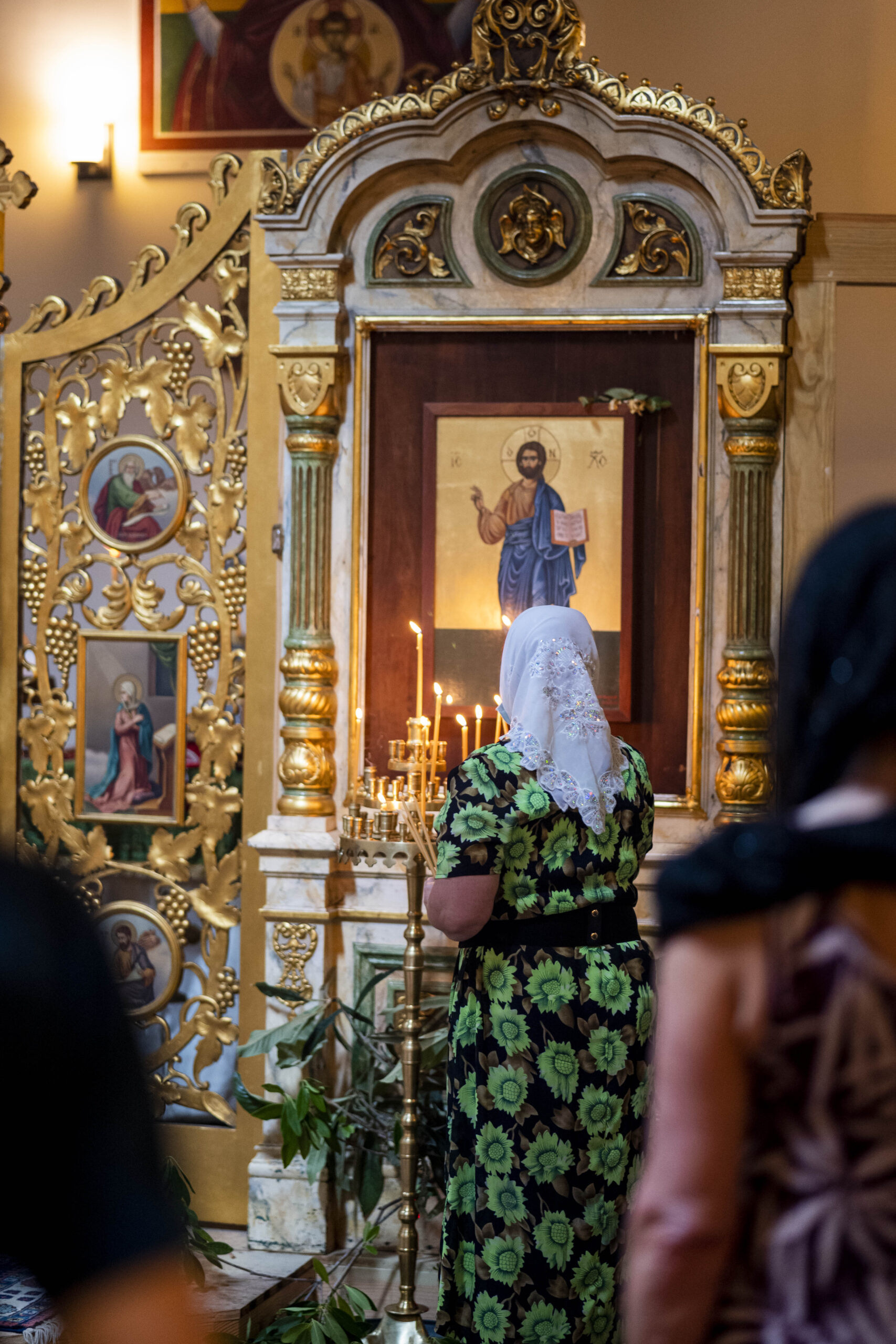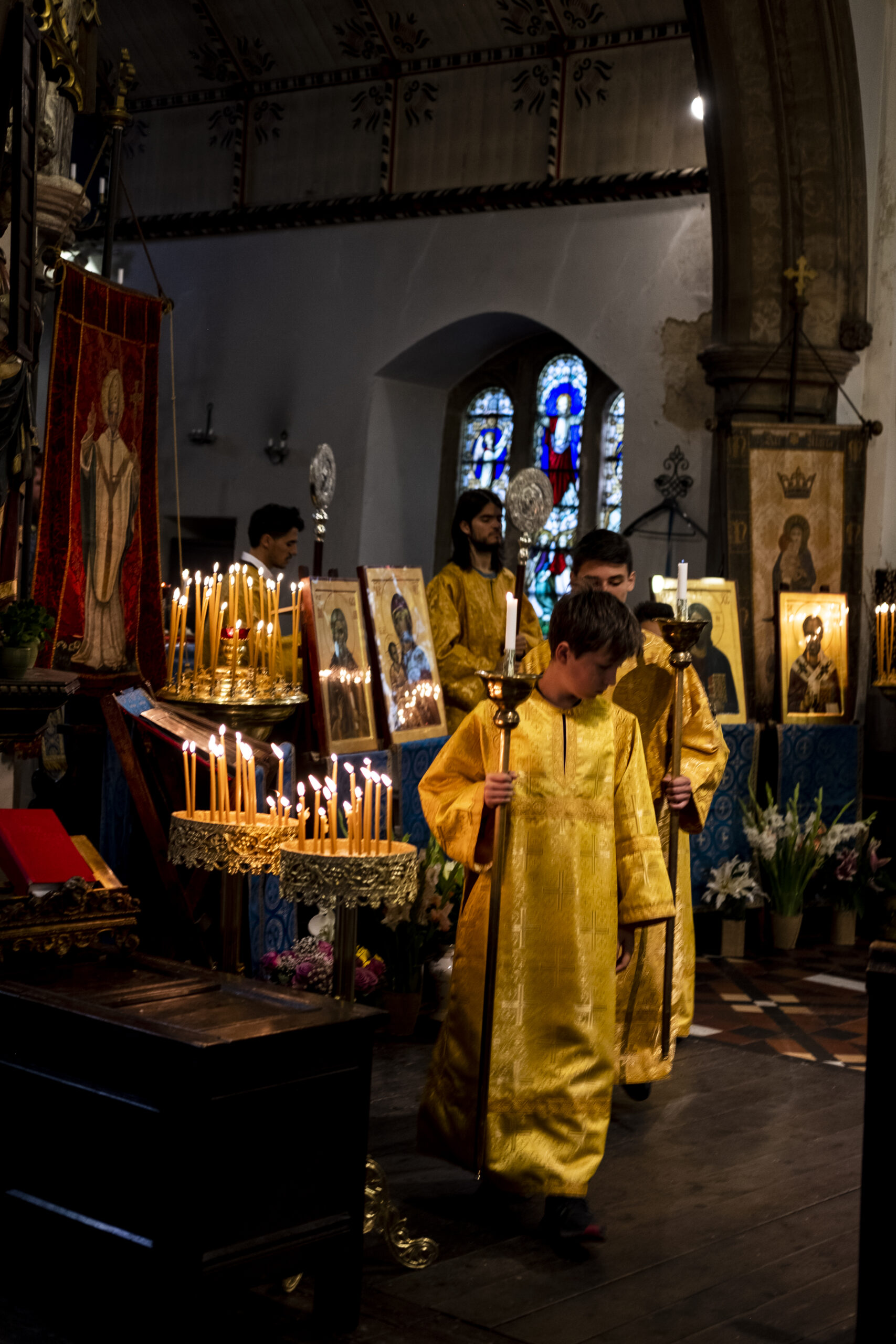Cultivating the Photographic Eye – Pictures That Tell Stories is a column exploring the divine in so-called humanist photography from the street to sacred. Photography gives us the ability to see God’s craftsmanship in a clear and insightful way, and that’s what we aim to pursue here. We’ll combine images with the written word to focus primarily on stories and themes that give us a glimpse into the tapestry of God’s creation that would be too expansive for us to see in one setting otherwise.
![]()
Just before dawn, the rooftop of this storefront church sizzled like a hot skillet when a whipsawing spring storm cut a rainy path through South Carolina’s Low Country. But now with daybreak creeping on the horizon and the bright morning sun beating back straggling storm clouds, Eastern Orthodox Christians begin to trickle into this place of worship for Matins.
Several female worshippers arrive first to this sanctuary in Summerville, South Carolina, that once operated as a movie theatre. Some don richly colored scarves on their heads and wear dresses with vivid floral patterns. The women light candles and cross themselves in the Orthodox fashion as the double door leading to the sanctuary creaks on its hinges.

Fr. Anastasy P. Yatrelis, the aged Greek priest tasked with shepherding this diverse flock of Eastern Europeans, walks into the church with a lopsided gait. He’s dragging a cumbersome clutch of storm-shorn tree limbs speckled with last night’s rain.
The cleric slips his head covering off and takes a deep breath, stooping over to arrange the limbs on the richly carpeted floor. Raindrops sparkle on the hem of the priest’s cassock like tiny diamonds. He fashions some boughs into a garland and places it near candlelit icons in preparation for the church’s celebration of the Feast of Pentecost. He scatters the other limbs throughout the room, garnishing the place with flashes of emerald-colored leaves.
“We lay branches on the floor for the Feast because green is the color of rebirth, much like spring,” Fr. Yatrelis offers in explanation. “And for us it is the color of Pentecost.”
The priest is almost gleeful. Thanks to last night’s storm, fallen tree limbs with budding green leaves carpeted the sidewalks and town square. The priest gathered armfuls of the windfall bounty for today’s celebration.
Saints Cyril and Methodius Orthodox Christian Church in Summerville, which Fr. Yatrelis leads, is an oasis for Orthodox believers. These coastal lowlands, like much of the American Deep South, are clinched tight in the Bible Belt. The town’s much larger neighbor, Charleston, South Carolina, boasts the stunning Greek Orthodox Church of the Holy Trinity. But in Summerville, you’re more likely to find Southern Baptist, AME, and Pentecostal churches on every street corner.
The Summerville Orthodox church offers the Divine Liturgy in Russian, Slavonic, and English. The latter language option is telling because among the congregation today, exiles from several mainline Protestant churches have come to participate in the divine service. They tell me they have found a home in the bosom of Orthodoxy. No matter the background, they’ve come to celebrate the feast.
“It’s a very important day for us,” says Fr. Yatrelis.

Today’s feast day can be traced to one of the most dramatic scenes in the book of Acts, when the resurrected Christ’s disciples gathered in Jerusalem during the Jewish Feast of Weeks.
Luke, the writer of Acts, uses electrifying prose in recounting how the Holy Spirit came down and filled the house where the believers had gathered with “a rushing mighty wind.” Luke further says:
“There appeared unto them cloven tongues like as of fire, and it sat upon each of them. And they were all filled with the Holy Ghost, and began to speak with other tongues, as the Spirit gave them utterance.” [1]
The flames dancing on candlesticks in the Summerville church are almost reminiscent of that wondrous day thousands of years ago. Elsewhere in the sanctuary, reds and gold-hued yellows pop in technicolor. Thick carpets with an Oriental flair cover the floor, festooned with the fresh green leaves of Fr. Yatrelis’s storm-fallen limbs. Objects of Orthodox devotion shimmer in the sacred space as candlelight etches the gaunt faces of Orthodox saints.
As Fr. Yatrelis finishes his tree branch arrangements among the skirting shadows and prepares for the service, more members of the congregation quietly enter. A middle-aged woman, clad in a brightly colored ankle-length dress, cradles a bouquet of flowers as tenderly as a newborn. She lights a candle, bows low, and then places the flowers before an icon. More worshippers arrive. The sanctuary is redolent with the scent of candle wax, tree sap, and incense. Each time the main door opens, a cool waft of spring air drifts into the room.

I grew up in Southern Baptist and Pentecostal churches where dogma superseded any hint of grace. Unaware of the expanse of God’s grace, in my adult life I became prone to any number of vices that threatened to wreck my body and disease my heart—both metaphorically and physiologically.
Yet even as an adult backslider, I nursed what I can only describe as evangelical conceit at the smoky and drawn-out liturgical services of Orthodoxy. But in time, and thanks to my work as a documentary photographer recording holy days with a camera, I soon came to see the graceful contours of liturgy.
Where once I heard only monotone repetition, I soon began to discern a worshipful language of adoration. In the past decade, I have experienced various divine services—in converted cotton barns in Texas hosting Indian worshipers, to an 800-year-old church in Oxford, England, where Romanian devotees gathered to share their bread and wine. It was there that I met newcomers exploring Orthodoxy, like Isabel from Hong Kong.
“I find beauty in the service,” she told me with a smile. During the service, I saw a handful of Romanian-speaking members of the church whispering English translations into the ears of believers like Isabel.

Back in Summerville, stark yellow rays seep into the sanctuary from an overhead skylight. Thick coils of incense from the censer Fr. Yatrelis is now swinging from his hand drift up to the rafters, mixing with prayers and chants. The air trembles with lengthening brushstrokes of chiaroscuro as this jaded believer, the son of a cigarette-rolling Baptist father and a sometimes-rebellious Pentecostal mother, breathes in the deep green of Pentecost.
![]()
[1] Acts 2:3-4 (King James Version)
The featured images are courtesy of Tommy Darin Liskey and are used with his kind permission for Cultivating.
Tommy Darin Liskey was born in Missouri but spent nearly a decade working as a journalist in Venezuela, Argentina and Brazil. He is a graduate of the University of Southern Mississippi. His poetry, fiction and non-fiction has appeared in The Red Truck Review, Deep South, Driftwood Press, Biostories, Spelk, Heartwood among others. His narrative and documentary photography has been published in The Museum of Americana, Change 7, The Blue Mountain Review, Cowboy Jamboree, Literary Life and Midwestern Gothic, among others. He lives in Texas with his family.
“I take a more documentary approach to photography, using the camera to explore faith in images, and hopefully, the human story, through unplanned street portraits of people I meet in my both my travels, and everyday life. As both a writer and photographer, I believe my calling is to be present. I pray that God choreographs the rest.”
Leave a Reply
A Field Guide to Cultivating ~ Essentials to Cultivating a Whole Life, Rooted in Christ, and Flourishing in Fellowship
Enjoy our gift to you as our Welcome to Cultivating! Discover the purpose of The Cultivating Project, and how you might find a "What, you too?" experience here with this fellowship of makers!


Add a comment
0 Comments